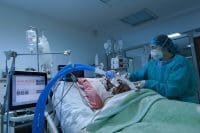It’s common for those who see demonstrations of mechanical patient-lift equipment to praise them as excellent tools.But when it comes to using this equipment in clinical practice, do these praises warrant such accolades?
Rarely have I encountered a patient-lift device incapable of performing to its intended specifications. Seldom have I come across a patient-lift device that I did not like. But as a safe patient handling (SPH) consultant, I’ve discovered that what’s more important than my preferences are the thoughts and perceptions of the staff I’ve asked to use these devices. Staff voices are key.
When implementing SPH programs, the overarching challenge revolves around the idea of inserting mechanical machines into settings that are intended to be nurturing and caring. It’s difficult for caregivers to find common ground between professional compassion and mechanical hoists/technology, especially because this level of innovation hasn’t previously existed in patient-care settings. Therefore, we need to ask ourselves: Are patient-lifts as good as advertised? Understand that if the purpose for patient lifts is to protect caregivers from injuries, then the answer is found within the beliefs and perceptions of the caregiver.
Listed below are three things to consider when evaluating appropriate patient-lift technology solutions.
- Patient-care setting where equipment will be used
Patient-lift equipment should be chosen according to patient mobility needs specific to the patient-care setting. Understanding a unit’s nursing practices related to the physical activities required to provide quality patient-care offers clarity into the type of equipment suitable for averting associated injury risks. Common patient-assisted mobility practices found on nursing units include turning-and-repositioning, assisting from bed-to-chair, and transferring from bed-to-stretcher. Combined with strategically guided safe patient handling processes with the assistance of mechanical patient-lifts, significant decreases in hospital acquired pressure injuries and patient falls are also achievable.
- Equipment complexity vs. simplicity
Given today’s high-tech society, we tend to become fascinated with technology that can do more while requiring us to do less, regardless of the innovation’s level of complexity or sophistication. Although this may be the case for more popular technological advancements, it seems to work counterintuitively when it comes to patient-lift technology. In injury prevention programs such as SPH, the success of the program relies heavily on staff’s willingness to use patient-lift equipment. I have found throughout my experiences that the less intimidating the mechanical lift, the more likely staff is to use it. “Bells” and “whistles” are exciting, but successful results are more closely related to simplicity and pragmatism.
- Safety considerations
Let’s face it, one of the biggest fears surrounding the use of over-head ceiling lifts is the thought of a patient potentially falling out of the equipment. This perception is one of the major reasons why staff is more likely not to use this equipment despite its ability to protect against debilitating musculoskeletal injuries. Most equipment on the market today comes equipped with important built-in safety features. Essential equipment considerations include emergency release mechanisms, meaning that there is a safety feature in place to ensure that patients can be lowered without being left to suspend in midair, and ease-of-use, meaning that equipment can be safely operated with one caregiver without the need for additional assistance during use. In addition, safe working loads or maximum weight capacities are established for each ceiling-lift hoist, and the International Organization for Standardization (ISO 10535) requires initial installations for overhead ceiling-lifts to be load-tested at 1.5 times the rated load capacity. This means that the ceiling lift can support more weight than its listed maximum weight capacity, though it is never recommended for the user to exceed the stated weight limit.
An important connection
Successful SPH programs are built on the strength of a solid patient-lift technology foundation. Though there are a variety of technological options to choose from, the considerations discussed here are aimed at helping you to choose the right equipment for your organization so that you can get the most value out of your equipment investments. Nevertheless, it should never be taken for granted the connection between appropriate patient-lift technology and staff’s belief that it is capable of contributing to quality patient care.
Roric P. Hawkins is the founder and president of The RP Hawkins Group (www.therphawkinsgroup.com) and is the safe patient handling coordinator at Michael E. DeBakey VAMC in Houston, TX. The views expressed here are his own.


















